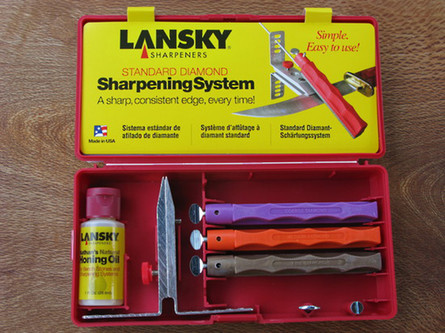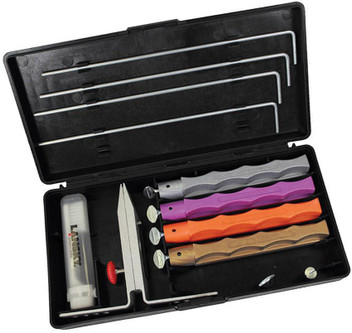Description
Deluxe 5-Stone System / Precision Knife Sharpening Kit
- Alumina Oxide and Ceramic Hones
Key Features:
-Easy to use, precision-engineered, multi-angle clamp to hold the blade securely
-Guide Rods are provided: One for every hone
-Extra Coarse Black Hone (70 grit) for re-profiling the bevel grind
-Coarse Red Hone (120 grit) for edge reconditioning
-Medium Green Hone (280 grit) for sharpening and less frequent touch-ups
-Fine Blue Hone (600 grit) for most frequent touch-ups to keep your blade paper-slicing sharp
-Ultra-Fine Ceramic Yellow Hone (1000 grit) for polishing the edge for a razor sharp edge
-Honing Oil Specially Formulated for sharpening (not recommended with diamond sharpeners, use water instead)
The Ultimate in Knife Sharpening Systems Technology! Safe, Easy and Convenient to Use; The Lansky Controlled Angle Sharpening System. Designed to give your blade a professional, razor sharp edge every time. All knife sharpener systems also include:
- Color-coated, finger-grooved safety holders mounted to stones
- Extra long knife clamp screws for thicker blades
- Custom molded storage/carrying case to hold all system components
- Complete easy-to-follow multi-lingual instructions
Sharpening Angles
17° Angle - A severe angle recommended for razor blades, scalpels or similar tools. Provides an extremely sharp but delicate edge.
20° Angle - A commonly used angle for higher quality blades and provides an excellent edge for kitchen cutlery and filet knives.
25° Angle - The recommended angle for most knives that need a durable, sharp edge. Ideal for hunting and outdoor knives.
30° Angle - An outstanding angle for knives that see the heavy use of cutting cardboard, wire or carpets. Recommended for heavy duty use.
Additional Kit Configurations
- Standard 3-Stone System (LKC03)
- Deluxe 5-Stone System (LKCLX)
- 3-Stone Standard Diamond System (LK3DM)
- Natural Arkansas System (LKNAT)
Instructions
How to sharpen a blade using your Lansky kit
These instructions are designed to acquaint you with the sharpening process.
For kit assembly and clamp usage instructions, please consult the informational booklet included with each kit.
Getting Started:
If blade is 7" or less in length:
- Position the clamp in the middle of the blade.
- After sharpening, flip the clamp (and blade) over and repeat the sharpening process on the unsharpened side.
If blade is greater than 7" in length:
- Pick the end of the blade where you would like to start sharpening and place the clamp two finger widths away from that end of the blade. (For example, if you choose the tip, place the clamp 2 finger widths from away the tip.)
- When you have the blade secured in the clamp, place your 2 fingers along both sides of the knife clamp. The area covered by your fingers (on both sides of the clamp) is your target sharpening zone. Try not to sharpen outside this zone, as this will change the angle of the hone and result in a poorly sharpened blade.
- Sharpen your target zone, and with the knife still secured in the clamp, flip the clamp (and knife) over and repeat this process on the other side of the blade.
- When you are finished with the first zone on both sides of the blade, measure another two-finger width starting at the edge of your freshly-sharpened area, and place the clamp next to your fingers.
- Sharpen this new target zone as you did the first, roughly using the same number of sharpening strokes.
- Your use of this method will minimize gaps and overlaps between your target zones, helping to ensure a continuous sharp edge when you are finished.
Hone selection:
- Always progress through the hones in order of decreasing coarseness—that is, start with a coarser hone and work your way down to the finest.
- The hone you begin with will vary depending on what type of sharpening you want to do.
- For aggressive sharpening tasks, such as changing the angle of a blade or sharpening a very dull edge, begin with the coarsest hone in your kit (coarse or extra-coarse), and then progress through medium, fine, etc.
- For lighter-duty sharpening jobs, like angle maintenance or general “touch-up" work, begin with the medium hone.
Sharpening Strokes:
- For best results, your strokes should move diagonally forward (towards the guide hole in the clamp) and along a small section of the blade, using the full length of the hone with each stroke.
- In the diagram at right, for instance, the first stroke would be from point A to point B. The hone would then be lifted and placed at point C, where the second stroke would begin.
Remember:
- Always sharpen into the blade! (Do NOT sharpen along the length of the blade, or away from the blade, as these could damage both the blade and your hone).
- It is important that you use approximately the same amount of strokes for each target sharpening zone, as this will help ensure a uniformly sharpened blade.
Oil Usage:
- Arkansas hones: When using these, apply a few drops of the honing oil provided to the surface of the stone before sharpening. Keep Arkansas stones oiled as you work.
- Standard hones (Alumina Oxide): Do not require oiling however you will note as you sharpen, that the stones will begin to move more smoothly. This indicates pores of the stones may be clogging with filings, which reduces the effectiveness of the stone. Clean by putting a few drops of oil on the hone. The oil will lift the metal shavings off the stone's surface where they can be wiped away with a rag.
- Diamond hones: Do not apply oil to the Lansky Diamond hones: clean diamond hones instead with water and wipe shavings away with a rag. Diamond hones should be completely dry before next usage.
Pressure:
- When using the coarse hone, apply a generous amount of pressure. As you move to the medium and fine hones, use less pressure.
Finishing Up:
- If when you have finished, the edge is still not as sharp as you would like, continue polishing the blade with your fine hone.
- If you have a single-sided or serrated blade, drag your fine hone down the length of the non-sharpened side a few times to clean off any stray metallic burrs that may have accumulated during sharpening.
Be Smart, Be Safe and Stay an Edge Above the Rest!
CAUTION: Knife sharpening is an inherently dangerous activity. Used properly this sharpening system cannot hurt you but a carelessly handled blade or pointed object can.
Source: lansky.com









